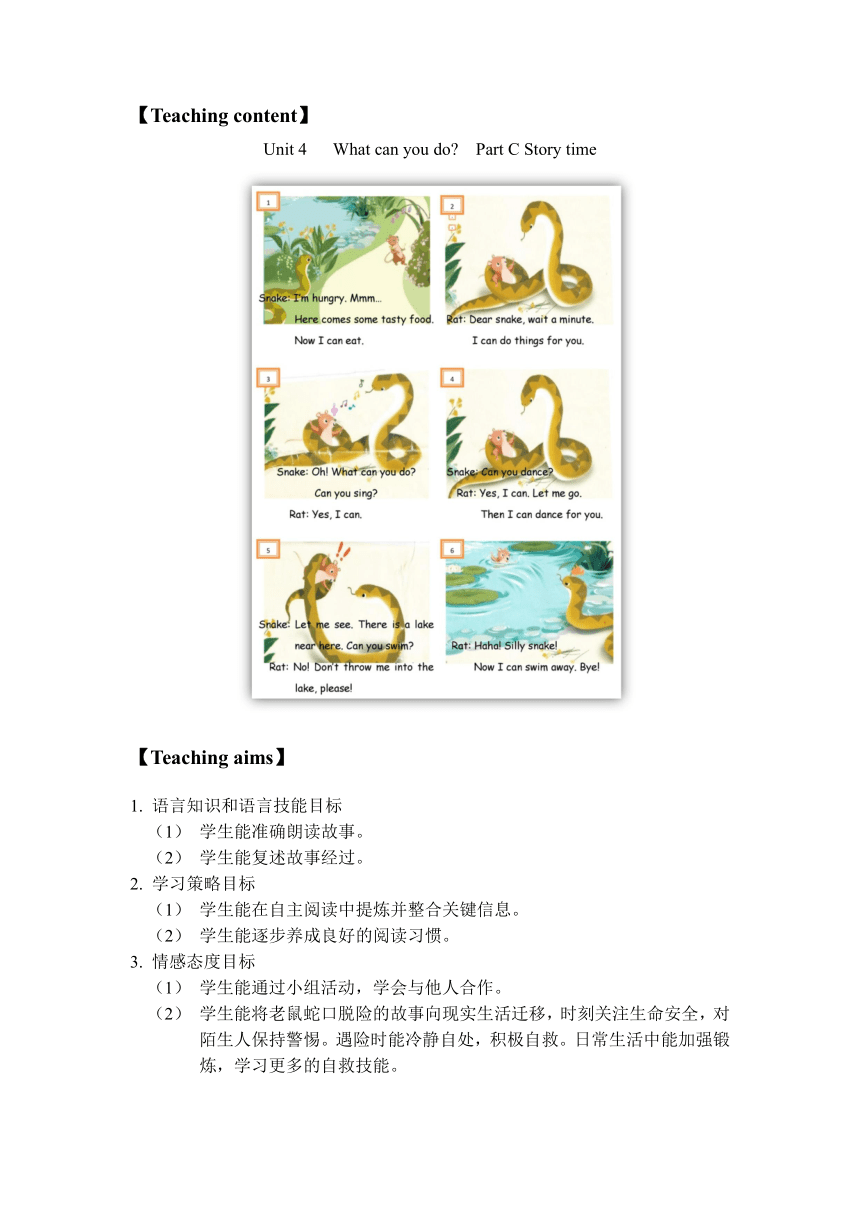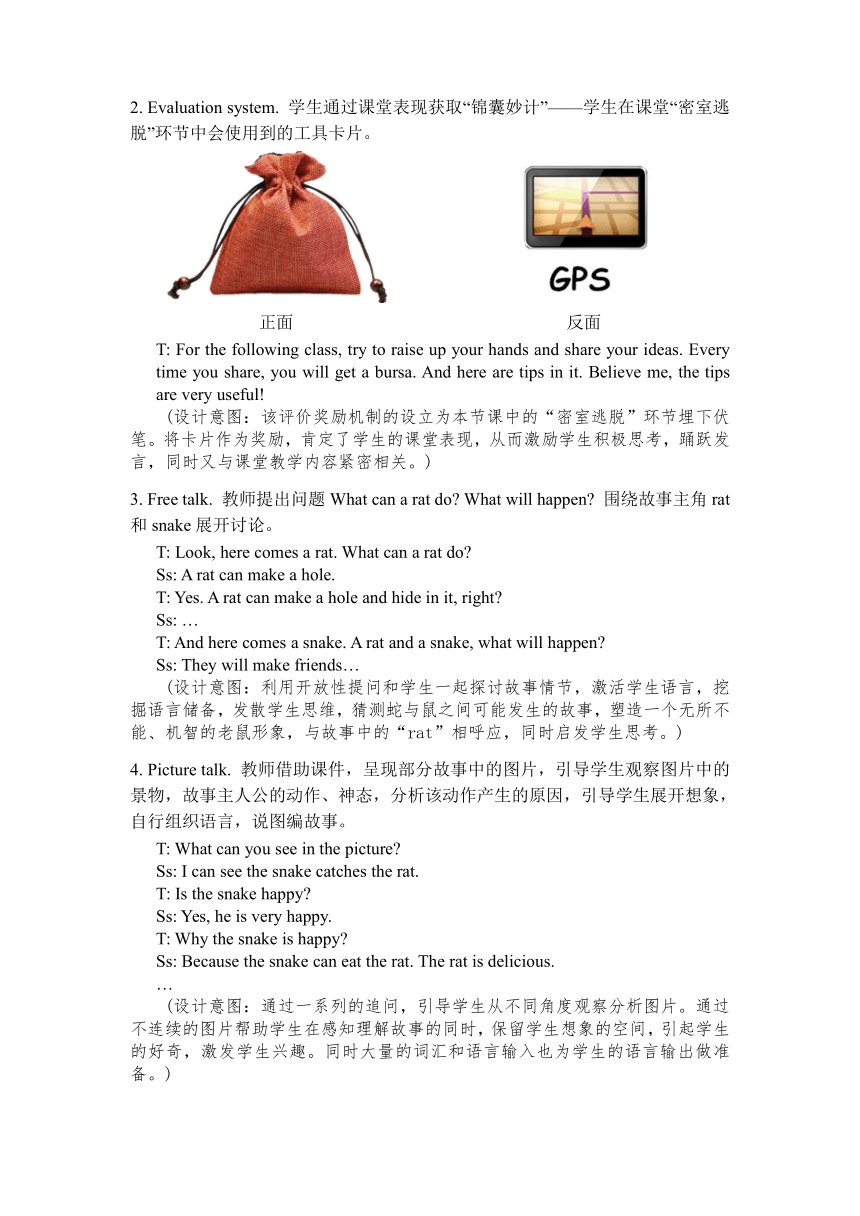Unit 4 What can you do? Part C Story time 教案
文档属性
| 名称 | Unit 4 What can you do? Part C Story time 教案 |  | |
| 格式 | zip | ||
| 文件大小 | 920.0KB | ||
| 资源类型 | 教案 | ||
| 版本资源 | 人教版(PEP) | ||
| 科目 | 英语 | ||
| 更新时间 | 2022-09-24 07:36:15 | ||
图片预览



文档简介
【Teaching content】
Unit 4 What can you do Part C Story time
【Teaching aims】
1. 语言知识和语言技能目标
学生能准确朗读故事。
学生能复述故事经过。
2. 学习策略目标
学生能在自主阅读中提炼并整合关键信息。
学生能逐步养成良好的阅读习惯。
3. 情感态度目标
学生能通过小组活动,学会与他人合作。
学生能将老鼠蛇口脱险的故事向现实生活迁移,时刻关注生命安全,对陌生人保持警惕。遇险时能冷静自处,积极自救。日常生活中能加强锻炼,学习更多的自救技能。
【Important points】
1. 学生能大声朗读故事、提炼关键信息,理解故事。
2. 学生能根据思维导图及关键词提示,组织语言复述故事,并表演故事。
【Difficult points】
1. 学生能根据关键信息提示,转述故事。
2. 学生能将故事迁移到实际生活中,总结自救方法。
【Teaching procedures】
Part I Ice-breaking
1. Warm- up. 教师通过游戏“Catch”与学生互动,激活课堂。学生右手平放,左手食指朝上,与左右两旁的同学相互连接,听到老师指令“catch”之后,右手尝试抓住同学的左手食指,左手食指尝试躲避同学右手的抓捕。教师可通过动作示范来辅助描述游戏规则。游戏中被抓住的同学将与老师进行对话互动。
T:Before our class, let’s play a game named catch. Put your hands like this, and try to connect with your classmates. When I say one, two, three, catch, the right hand tries to catch, and the left finger tries to go. Got it
Ss: Yes.
T:One, two, three, catch! Who’s been caught
Ss: Me.
T: What’s your name
Ss: …
(设计意图:破冰暖场环节。通过游戏与学生相互认识,问候,建立融洽和谐的师生关系,打造轻松活泼的课堂气氛。“catch”是故事的起因并贯穿整个故事。利用游戏帮助学生巩固理解“catch”的含义,为导入新课做铺垫。)
Part II Brainstorming
1. Lead-in. 承接“catch”游戏,通过与学生交流总结,借助课件动画展示,导入新课。如下:
T: Is the catch game funny
Ss: Yes, it’s funny.
T: So, catch is a good word or a bad word
Ss: Good word.
T: Yeah, I think so. If you are beautiful, you will catch people’s eyes. If you work hard, you will catch up with your classmates. But not all the catch is that good or funny, especially when an evil snake catches a little rat. Look! Will the rat die Or, will the rat win That’s our story today The Snake and the Rat.
(设计意图:游戏之余引导学生积极思考、总结,让学生从兴奋的情绪中沉淀下来。在与学生交流的过程中,引导学生进行语言输出,为后续活动做铺垫。)
2. Evaluation system. 学生通过课堂表现获取“锦囊妙计”——学生在课堂“密室逃脱”环节中会使用到的工具卡片。
正面 反面
T: For the following class, try to raise up your hands and share your ideas. Every time you share, you will get a bursa. And here are tips in it. Believe me, the tips are very useful!
(设计意图:该评价奖励机制的设立为本节课中的“密室逃脱”环节埋下伏笔。将卡片作为奖励,肯定了学生的课堂表现,从而激励学生积极思考,踊跃发言,同时又与课堂教学内容紧密相关。)
3. Free talk. 教师提出问题What can a rat do What will happen 围绕故事主角rat和snake展开讨论。
T: Look, here comes a rat. What can a rat do
Ss: A rat can make a hole.
T: Yes. A rat can make a hole and hide in it, right
Ss: …
T: And here comes a snake. A rat and a snake, what will happen
Ss: They will make friends…
(设计意图:利用开放性提问和学生一起探讨故事情节,激活学生语言,挖掘语言储备,发散学生思维,猜测蛇与鼠之间可能发生的故事,塑造一个无所不能、机智的老鼠形象,与故事中的“rat”相呼应,同时启发学生思考。)
4. Picture talk. 教师借助课件,呈现部分故事中的图片,引导学生观察图片中的景物,故事主人公的动作、神态,分析该动作产生的原因,引导学生展开想象,自行组织语言,说图编故事。
T: What can you see in the picture
Ss: I can see the snake catches the rat.
T: Is the snake happy
Ss: Yes, he is very happy.
T: Why the snake is happy
Ss: Because the snake can eat the rat. The rat is delicious.
…
(设计意图:通过一系列的追问,引导学生从不同角度观察分析图片。通过不连续的图片帮助学生在感知理解故事的同时,保留学生想象的空间,引起学生的好奇,激发学生兴趣。同时大量的词汇和语言输入也为学生的语言输出做准备。)
Part III Constructing
1. Hand puppets show. 教师利用课件创设故事情景,以故事讲述者的身份,对故事文本内容进行扩充,将单一的对话串连起来并融入到情景中去,同时借助蛇与鼠的手偶来演绎故事,使故事更加饱满生动。学生带着问题“Did the snake eat the rat What can the rat do ”初步感知故事。
T: Now you’re gonna see a short hand puppets show. Before the show, I have two questions. Did the snake eat the rat What can the rat do
(设计意图:学生通过观看手偶表演,初步整体感知故事情节。观前提问能引导学生有意识的去关注故事情节。该部分表演也能对学生表演起示范作用。)
2. Find the key words. 学生自主阅读故事,并划出关键词。
T: Read the story loudly, when you are reading, you can use your pen to underline the key words, they will help you to understand and memorize the story.
(设计意图:教师帮助学生总结出通过关键词抓关键信息这一阅读策略,培养学生提炼关键词的阅读习惯,以及提取重要信息的能力。)
3. Check the key words and explain the difficult parts. 教师利用TPR教学帮助学生理解记忆关键词,并引导学生对关键词进行整合,提炼关键词所对应的故事情节,构建思维导图。
T: Look at this page, what are the key words
Ss: Hungry.
T: Yes. Who is hungry in the story
Ss: The snake is hungry.
T: So he wants to eat some…
Ss: Tasty food.
…
(设计意图:帮助学生整合重要信息,学会构建思维导图这一阅读策略。课本中的故事文本是以对话形式呈现,该环节可引导学生以故事讲述者的身份对故事进行转述。)
4. Game: I say you do. 教师大声朗读关键词,学生表演相应动作。然后部分学生大声朗读关键词,其余学生表演相应动作。
T: I’ll say the key words and you do the actions. / I ‘ll ask two students come to the front, you say the keywords and they do the actions.
(设计意图:游戏激趣的同时,帮助学生巩固理解并记忆关键词,进一步理解并记忆故事情节,为复述故事,表演故事做语言储备。)
Part IV Producing
1. Retell the story. 根据板书导图和关键词提示,复述故事。
T: Look, we have all the key words on the blackboard, and we have the whole story on the blackboard too. Let’s try to retell.
(设计意图:培养学生从感知故事--细读故事--提炼整合关键信息--组织语言--复述故事的完整的阅读策略和方法。学生通过复述故事,将原本的对话文本转换成了以第三人称叙述的故事文本,且可作为本节课表演展示环节的旁白。)
2. Let’s chant. 教师将学生提炼出的关键信息,编成朗朗上口的chant, 然后师生一起有节奏地打响指读chant(三遍,逐次加快)。
T: We have the whole story as a chant here, let’s read together and let’s chant together.
(设计意图:作为复述故事部分教学的总结环节,再次巩固故事内容,并引导学生学习编排chant的趣味方法,延续学生学习的兴趣。)
3. Group work: Read the story and act out. 学生以小组为单位,朗读故事,编排表演故事,并融入自己的创意。
T: Now, you’re gonna read the story carefully and then act out. You’re gonna read like a snake, and you’re gonna move like a snake. You can be a story teller, or you can be a beautiful sun flower. You can be whatever you imagine, so just add some creative things in your play.
…
T: It’s time for you to show your play, and to show yourself.
(设计意图:此环节是学生语言输出的过程。学生能在团队合作中体会到学和用的乐趣,获得成就感,增强学习英语的兴趣和信心,增进同学情谊。)
4. Free talk: What do you think of the rat 学生自由发言,帮助学生分析、挖掘故事中老鼠的特质,引导学生学习老鼠的机智,聪慧,勇敢,冷静。
T: What do you think of the rat When he was caught by the snake, did he cry
Ss: No, he didn’t. He is brave.
T: Did he scream
Ss: …
(设计意图:此环节亦是学生语言输出的过程。引导学生在感受故事的乐趣之余,以故事中老鼠的机智为切入点,挖掘老鼠身上值得学习的特征,以及故事所蕴含的“遇事冷静”“积极自救”的深刻道理。)
Part V Evaluating and Consolidating
1. Room breaking. 教师借助课件,设置学生被坏人抓住的情景,让学生结合自己已获取的“锦囊妙计”,在小组内讨论密室逃脱的方法,并进行汇报。
T: Imagine you’ve been caught by a bad man, and locked in a dark room with your hands tied. How can you get out You can find tips in your bursa. Discuss it with your group members.
(设计意图:密室逃脱是学生非常熟悉又特别感兴趣的游戏,能激发学生说的欲望。通过设置被困住的情景,将故事向现实生活迁移。引入“如何逃脱”这个问题,能引起学生思考,发散学生思维。学生在进行分析阐述逃脱经过的同时,也是在总结积极自救的方法。该环节在对学生进行生命安全教育的同时,帮助学生提高安全意识。)
2. Free talk: What did you learn 学生自由发言,谈谈本节课的收获。
T: What can you learn from this class
Ss: We can learn to swim.
T: Yes, we can learn to swim, learn to use a GPS, we need to learn more skills in our daily life.
…
(设计意图:让学生学会总结,再次进行生命安全教育。)
3. Homework: Tell the story to your friends.
Read more picture books like The Door Bell Rang.
Learn more self-rescue skills.
(设计意图:引导学生课后进行巩固训练,培养学生阅读绘本故事的习惯,引导学生学习更多的自救技能。)
【Blackboard design】
Unit 4 What can you do Part C Story time
【Teaching aims】
1. 语言知识和语言技能目标
学生能准确朗读故事。
学生能复述故事经过。
2. 学习策略目标
学生能在自主阅读中提炼并整合关键信息。
学生能逐步养成良好的阅读习惯。
3. 情感态度目标
学生能通过小组活动,学会与他人合作。
学生能将老鼠蛇口脱险的故事向现实生活迁移,时刻关注生命安全,对陌生人保持警惕。遇险时能冷静自处,积极自救。日常生活中能加强锻炼,学习更多的自救技能。
【Important points】
1. 学生能大声朗读故事、提炼关键信息,理解故事。
2. 学生能根据思维导图及关键词提示,组织语言复述故事,并表演故事。
【Difficult points】
1. 学生能根据关键信息提示,转述故事。
2. 学生能将故事迁移到实际生活中,总结自救方法。
【Teaching procedures】
Part I Ice-breaking
1. Warm- up. 教师通过游戏“Catch”与学生互动,激活课堂。学生右手平放,左手食指朝上,与左右两旁的同学相互连接,听到老师指令“catch”之后,右手尝试抓住同学的左手食指,左手食指尝试躲避同学右手的抓捕。教师可通过动作示范来辅助描述游戏规则。游戏中被抓住的同学将与老师进行对话互动。
T:Before our class, let’s play a game named catch. Put your hands like this, and try to connect with your classmates. When I say one, two, three, catch, the right hand tries to catch, and the left finger tries to go. Got it
Ss: Yes.
T:One, two, three, catch! Who’s been caught
Ss: Me.
T: What’s your name
Ss: …
(设计意图:破冰暖场环节。通过游戏与学生相互认识,问候,建立融洽和谐的师生关系,打造轻松活泼的课堂气氛。“catch”是故事的起因并贯穿整个故事。利用游戏帮助学生巩固理解“catch”的含义,为导入新课做铺垫。)
Part II Brainstorming
1. Lead-in. 承接“catch”游戏,通过与学生交流总结,借助课件动画展示,导入新课。如下:
T: Is the catch game funny
Ss: Yes, it’s funny.
T: So, catch is a good word or a bad word
Ss: Good word.
T: Yeah, I think so. If you are beautiful, you will catch people’s eyes. If you work hard, you will catch up with your classmates. But not all the catch is that good or funny, especially when an evil snake catches a little rat. Look! Will the rat die Or, will the rat win That’s our story today The Snake and the Rat.
(设计意图:游戏之余引导学生积极思考、总结,让学生从兴奋的情绪中沉淀下来。在与学生交流的过程中,引导学生进行语言输出,为后续活动做铺垫。)
2. Evaluation system. 学生通过课堂表现获取“锦囊妙计”——学生在课堂“密室逃脱”环节中会使用到的工具卡片。
正面 反面
T: For the following class, try to raise up your hands and share your ideas. Every time you share, you will get a bursa. And here are tips in it. Believe me, the tips are very useful!
(设计意图:该评价奖励机制的设立为本节课中的“密室逃脱”环节埋下伏笔。将卡片作为奖励,肯定了学生的课堂表现,从而激励学生积极思考,踊跃发言,同时又与课堂教学内容紧密相关。)
3. Free talk. 教师提出问题What can a rat do What will happen 围绕故事主角rat和snake展开讨论。
T: Look, here comes a rat. What can a rat do
Ss: A rat can make a hole.
T: Yes. A rat can make a hole and hide in it, right
Ss: …
T: And here comes a snake. A rat and a snake, what will happen
Ss: They will make friends…
(设计意图:利用开放性提问和学生一起探讨故事情节,激活学生语言,挖掘语言储备,发散学生思维,猜测蛇与鼠之间可能发生的故事,塑造一个无所不能、机智的老鼠形象,与故事中的“rat”相呼应,同时启发学生思考。)
4. Picture talk. 教师借助课件,呈现部分故事中的图片,引导学生观察图片中的景物,故事主人公的动作、神态,分析该动作产生的原因,引导学生展开想象,自行组织语言,说图编故事。
T: What can you see in the picture
Ss: I can see the snake catches the rat.
T: Is the snake happy
Ss: Yes, he is very happy.
T: Why the snake is happy
Ss: Because the snake can eat the rat. The rat is delicious.
…
(设计意图:通过一系列的追问,引导学生从不同角度观察分析图片。通过不连续的图片帮助学生在感知理解故事的同时,保留学生想象的空间,引起学生的好奇,激发学生兴趣。同时大量的词汇和语言输入也为学生的语言输出做准备。)
Part III Constructing
1. Hand puppets show. 教师利用课件创设故事情景,以故事讲述者的身份,对故事文本内容进行扩充,将单一的对话串连起来并融入到情景中去,同时借助蛇与鼠的手偶来演绎故事,使故事更加饱满生动。学生带着问题“Did the snake eat the rat What can the rat do ”初步感知故事。
T: Now you’re gonna see a short hand puppets show. Before the show, I have two questions. Did the snake eat the rat What can the rat do
(设计意图:学生通过观看手偶表演,初步整体感知故事情节。观前提问能引导学生有意识的去关注故事情节。该部分表演也能对学生表演起示范作用。)
2. Find the key words. 学生自主阅读故事,并划出关键词。
T: Read the story loudly, when you are reading, you can use your pen to underline the key words, they will help you to understand and memorize the story.
(设计意图:教师帮助学生总结出通过关键词抓关键信息这一阅读策略,培养学生提炼关键词的阅读习惯,以及提取重要信息的能力。)
3. Check the key words and explain the difficult parts. 教师利用TPR教学帮助学生理解记忆关键词,并引导学生对关键词进行整合,提炼关键词所对应的故事情节,构建思维导图。
T: Look at this page, what are the key words
Ss: Hungry.
T: Yes. Who is hungry in the story
Ss: The snake is hungry.
T: So he wants to eat some…
Ss: Tasty food.
…
(设计意图:帮助学生整合重要信息,学会构建思维导图这一阅读策略。课本中的故事文本是以对话形式呈现,该环节可引导学生以故事讲述者的身份对故事进行转述。)
4. Game: I say you do. 教师大声朗读关键词,学生表演相应动作。然后部分学生大声朗读关键词,其余学生表演相应动作。
T: I’ll say the key words and you do the actions. / I ‘ll ask two students come to the front, you say the keywords and they do the actions.
(设计意图:游戏激趣的同时,帮助学生巩固理解并记忆关键词,进一步理解并记忆故事情节,为复述故事,表演故事做语言储备。)
Part IV Producing
1. Retell the story. 根据板书导图和关键词提示,复述故事。
T: Look, we have all the key words on the blackboard, and we have the whole story on the blackboard too. Let’s try to retell.
(设计意图:培养学生从感知故事--细读故事--提炼整合关键信息--组织语言--复述故事的完整的阅读策略和方法。学生通过复述故事,将原本的对话文本转换成了以第三人称叙述的故事文本,且可作为本节课表演展示环节的旁白。)
2. Let’s chant. 教师将学生提炼出的关键信息,编成朗朗上口的chant, 然后师生一起有节奏地打响指读chant(三遍,逐次加快)。
T: We have the whole story as a chant here, let’s read together and let’s chant together.
(设计意图:作为复述故事部分教学的总结环节,再次巩固故事内容,并引导学生学习编排chant的趣味方法,延续学生学习的兴趣。)
3. Group work: Read the story and act out. 学生以小组为单位,朗读故事,编排表演故事,并融入自己的创意。
T: Now, you’re gonna read the story carefully and then act out. You’re gonna read like a snake, and you’re gonna move like a snake. You can be a story teller, or you can be a beautiful sun flower. You can be whatever you imagine, so just add some creative things in your play.
…
T: It’s time for you to show your play, and to show yourself.
(设计意图:此环节是学生语言输出的过程。学生能在团队合作中体会到学和用的乐趣,获得成就感,增强学习英语的兴趣和信心,增进同学情谊。)
4. Free talk: What do you think of the rat 学生自由发言,帮助学生分析、挖掘故事中老鼠的特质,引导学生学习老鼠的机智,聪慧,勇敢,冷静。
T: What do you think of the rat When he was caught by the snake, did he cry
Ss: No, he didn’t. He is brave.
T: Did he scream
Ss: …
(设计意图:此环节亦是学生语言输出的过程。引导学生在感受故事的乐趣之余,以故事中老鼠的机智为切入点,挖掘老鼠身上值得学习的特征,以及故事所蕴含的“遇事冷静”“积极自救”的深刻道理。)
Part V Evaluating and Consolidating
1. Room breaking. 教师借助课件,设置学生被坏人抓住的情景,让学生结合自己已获取的“锦囊妙计”,在小组内讨论密室逃脱的方法,并进行汇报。
T: Imagine you’ve been caught by a bad man, and locked in a dark room with your hands tied. How can you get out You can find tips in your bursa. Discuss it with your group members.
(设计意图:密室逃脱是学生非常熟悉又特别感兴趣的游戏,能激发学生说的欲望。通过设置被困住的情景,将故事向现实生活迁移。引入“如何逃脱”这个问题,能引起学生思考,发散学生思维。学生在进行分析阐述逃脱经过的同时,也是在总结积极自救的方法。该环节在对学生进行生命安全教育的同时,帮助学生提高安全意识。)
2. Free talk: What did you learn 学生自由发言,谈谈本节课的收获。
T: What can you learn from this class
Ss: We can learn to swim.
T: Yes, we can learn to swim, learn to use a GPS, we need to learn more skills in our daily life.
…
(设计意图:让学生学会总结,再次进行生命安全教育。)
3. Homework: Tell the story to your friends.
Read more picture books like The Door Bell Rang.
Learn more self-rescue skills.
(设计意图:引导学生课后进行巩固训练,培养学生阅读绘本故事的习惯,引导学生学习更多的自救技能。)
【Blackboard design】
